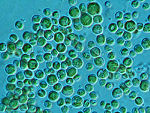Chlorella minutissima
| Chlorella minutissima [1] | ||||||||||||||
|---|---|---|---|---|---|---|---|---|---|---|---|---|---|---|
[[image: |200px|]] |200px|]] | ||||||||||||||
| Scientific classification | ||||||||||||||
| ||||||||||||||
| Binomial name | ||||||||||||||
| Chlorella minutissima |
Description and significance
Chlorella minutissima is a unicellular marine alga that has chlorophyll a and b, and synthesizes starch, like plants. The microalgae is spherical in shape and lack a flagella. Chlorella, from Greek word chloros, green and the Latin suffix ella means "small" .Some sources classify algae as plants, such as the Australian Antarctic Data Centre.[2] However, algae are more often categorized into Kingdom Protista, which belongs to domain Eukarya. Therefore algae have membrane enclosed nucleus, yet the internal structures of algae are simpler than those of plants. Chlorella minutissima is rich in amino acids and polyunsaturated fatty acids, particularly eicosapentaenoic acid (20:5co3), which makes Chlorella minutissima potentially useful in health foods and pharmaceuticals.[3] In the past Chorella minutissima has been considered to be used as a protein source to the world population to solve the problem of hunger due to two World Wars and the increasing world population. Scientists later found that to produce Chlorella minutissima massively under ideal conditions, the condition would take a very high cost to maintain. The microalgae is an important component in finfish and shellfish aquaculture[4], therefore research has been done in maximizing the growth and storage of Chlorella minutissima.
Genome structure
Nuclear-encoded small subunit ribosomal RNA gene (18SrDNA) sequences of Chlorella minutissima and closely related species were determined[5] There is little published information on the genome of Chlorella minutissima. The microbe is haploid and lacks a sexual cycle, therefore it is not very useful in the study of genetics.
Cell structure and metabolism
Chlorella minutissima is unicellular without flagella. The growth of Chlorella minutissima does not require the presence of secondary carotenoids, thiamine and vitamin B12. The lower limit of pH toleration of Chlorella minutissima is 5.5 and the upper temperature limit of growth is 32 °C (89.6 °F). The maximum toleration to NaCl is 1%[5] Research on Chlorella minutissima has been performed to test the composition of fatty acids under various conditions. The growth of Chlorella minutissima in low light intensity is about 1/5 of that in high light intensity. Light intensity has little effect on total content of fatty acid, but it does affect the composition of fatty acids[6] Chlorella minutissima is a well defined species in its phenotypic and genotypic features. The DNA base composition of Chlorella minutissima is sensitive acidic and high salt conditions[7]
Ecology
Chlorella minutissima has a fast growth rate and a high polyunsaturated fatty acid content. At higher concentrations of herbicide SAN 9785, Chlorella minutissima cells were substantially lyzed, and the cells remain unlysed did not grown further in 10 weeks. At lower concentrations of SAN 9785 (0.2 and 0.4 mM), the growth rate of Chlorella minutissima was suppressed, and the degree of suppression was proportional to the concentration of SAN 9785[8]
Current Research
Health foods and pharmaceuticals
Chlorella minutissima has high content of polyunsaturated fatty acids, particularly eicosapentaenoic acid (20:5ω3), which is important for mammals as an agent to prevent blood platelet aggregation. 20:5ω3 is also one of the precursors for prostaglandin. Since the synthesis of ω3 PUFA in marine fishes is very low and marine fishes acquire ω3 from diet, it is tempting to speculate that people may benefit from ingesting marine microalgae and receive polyunsaturated fatty acids[6]
Reduction of Carbon Dioxide Pollution
Microalgae has much higher growth rate than higher plants and can grow under high carbon dioxide concentrations that is unsuitable for higher plants. Chlorella minutissima can grow under extreme carbon dioxide concentrations (0.036–100%). There is a strong increase in the microalgal biomass during photosynthesis when CO2 is high. However, microalgal biomass increase also requires high light intensity. Maintaining high light intensity require a high cost, therefore the use of microalgae to reduce carbon dioxide pollution is limited to small scale practice such as for factoies[9]
Cryopreservation
Chlorella minutissima gives excellent results when grown at 4 °C (39.2 °F) with all cryoprotectants. However, the unprotected cultures (without cryoprotectants) failed to regenerate at low temperature. Cryopreservation of microalgae has been proven both in nature and in laboratory. Cryoprotectants have to be less than 1% in concentration[10].
References
- ↑ http://www.uniprot.org/taxonomy/3081
- ↑ http://data.aad.gov.au/aadc/biodiversity/taxon_profile.cfm?taxon_id=116567
- ↑ Seto,A., Wang,H.L. and Hesseltine,C.W. Culture Conditions Affect Eicosapentaenoic Acid Content of Chlorella minutissima. Journal of the American Oil Chemists' Society, Volume 61, Number 5. May, 1984, p.892-894
- ↑ Tzovenisa, I., Triantaphyllidisb, G., Naihongc, X., Chatzinkolaoua, E., Papadopouloua, K., Xouria, G., Tafasa, T. Cryopreservation of marine microalgae and potential toxicity of cryoprotectants to the primary steps of the aquacultural food chain. Aquaculture, 230, 2004, p.457–473
- ↑ 5.0 5.1 Volker AR Huss, Claudia Ciniglia, Paola Cennamo, Salvatore Cozzolino,Gabriele Pinto and Antonino Pollio. Phylogenetic relationships and taxonomic position of Chlorella-like isolates from low pH environments (pH < 3.0). BMC Evolutionary Biology, 26 August 2002. 2:13
- ↑ 6.0 6.1 AKIRA SETO 1, H.L. WANG and C.W. HESSELTINE. Culture Conditions Affect Eicosapentaenoic Acid Content of Chlorella minutissima. Northern Regional Research Center, Agricultural Research Service, USDA, Peoria, Illinois 61604
- ↑ A. R. Huss, T. K. Scharpf, and E. Kessler. Deoxyribonucleic acid reassociation in the taxonomy of the genus Chlorella V. Chlorella vulgaris, C. luteoviridis, C. minutissima, and C. zofingiensis. Arch Microbiol (1989) t 52:512- 514
- ↑ Deepa Kachroo, Shaneen M. Singh Jolly, Viraraghavan Ramamurthy. Modulation of unsaturated fatty acids content in algae Spirulina platensis and Chlorella minutissima in response to herbicide SAN 9785. Electronic Journal of Biotechnology. Vol.9 No.4, Issue of July 15, 2006
- ↑ Aikaterini Papazi, Pavlos Makridis, Pascal Divanach and Kiriakos Kotzabasis. Bioenergetic changes in the microalgal photosynthetic apparatus by extremely high CO2 concentrations induce an intense biomass production. Physiologia Plantarum 132: 338–349. 2008
- ↑ I. Tzovenis, G. Triantaphyllidis, X. Naihong, E. Chatzinikolaou, K. Papadopoulou, G. Xouri, T. Tafas. Cryopreservation of marine microalgae and potential toxicity of cryoprotectants to the primary steps of the aquacultural food chain. Aquaculture 230 (2004) 457–473
